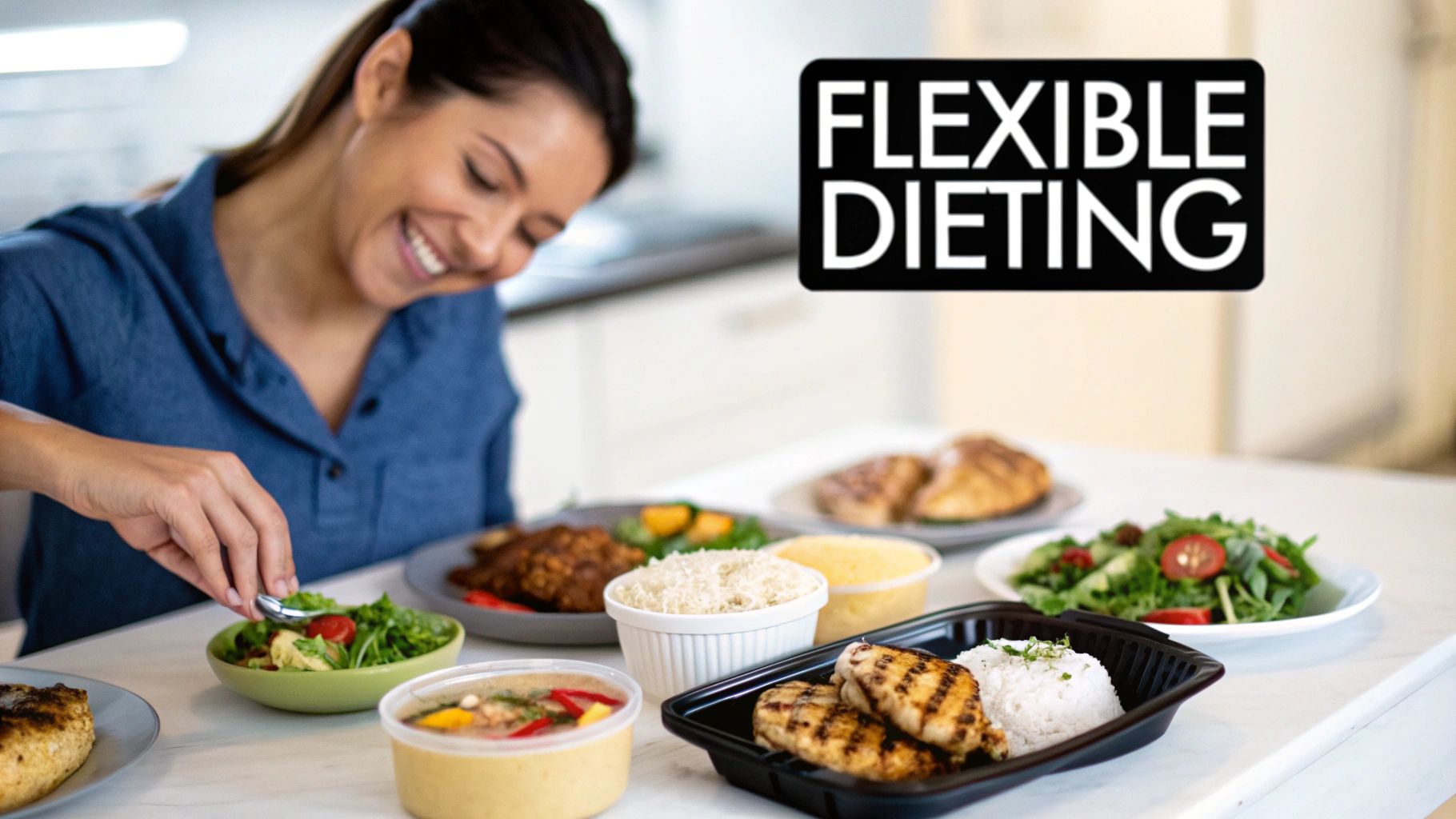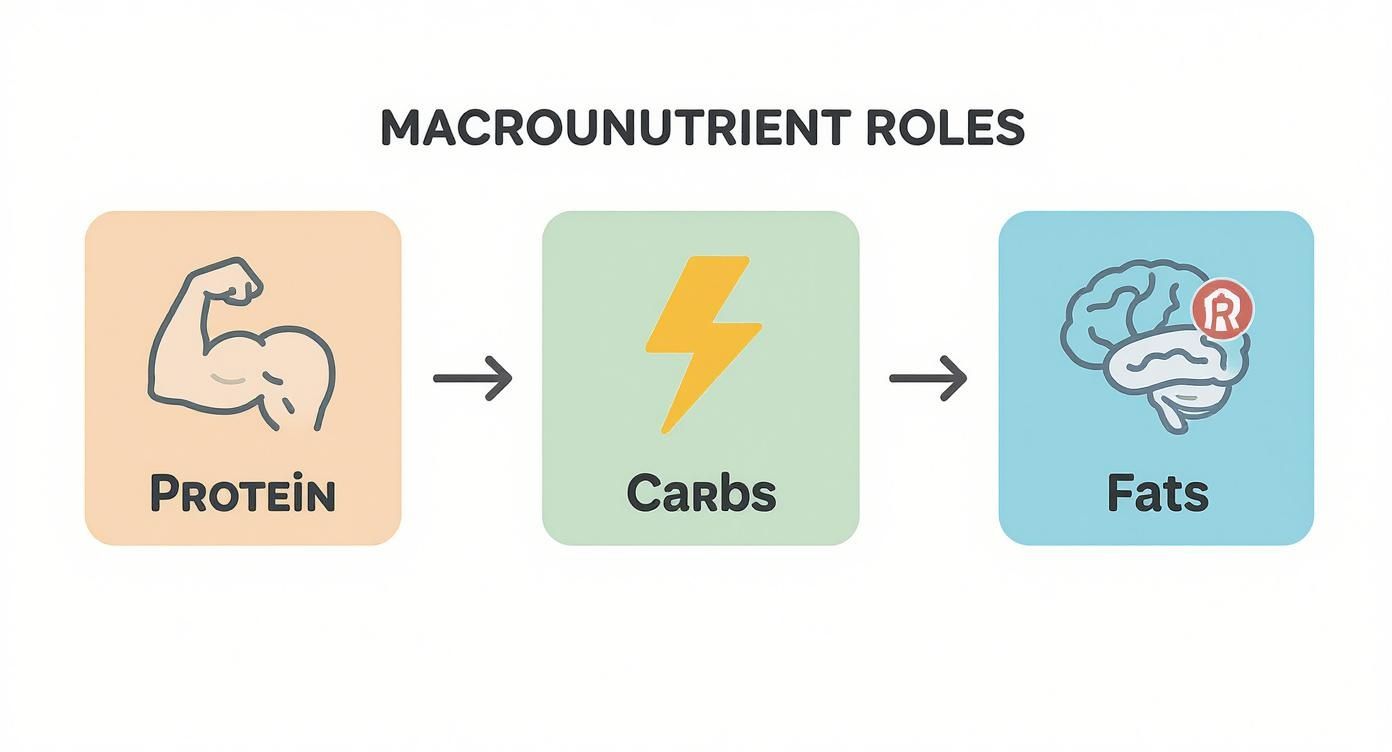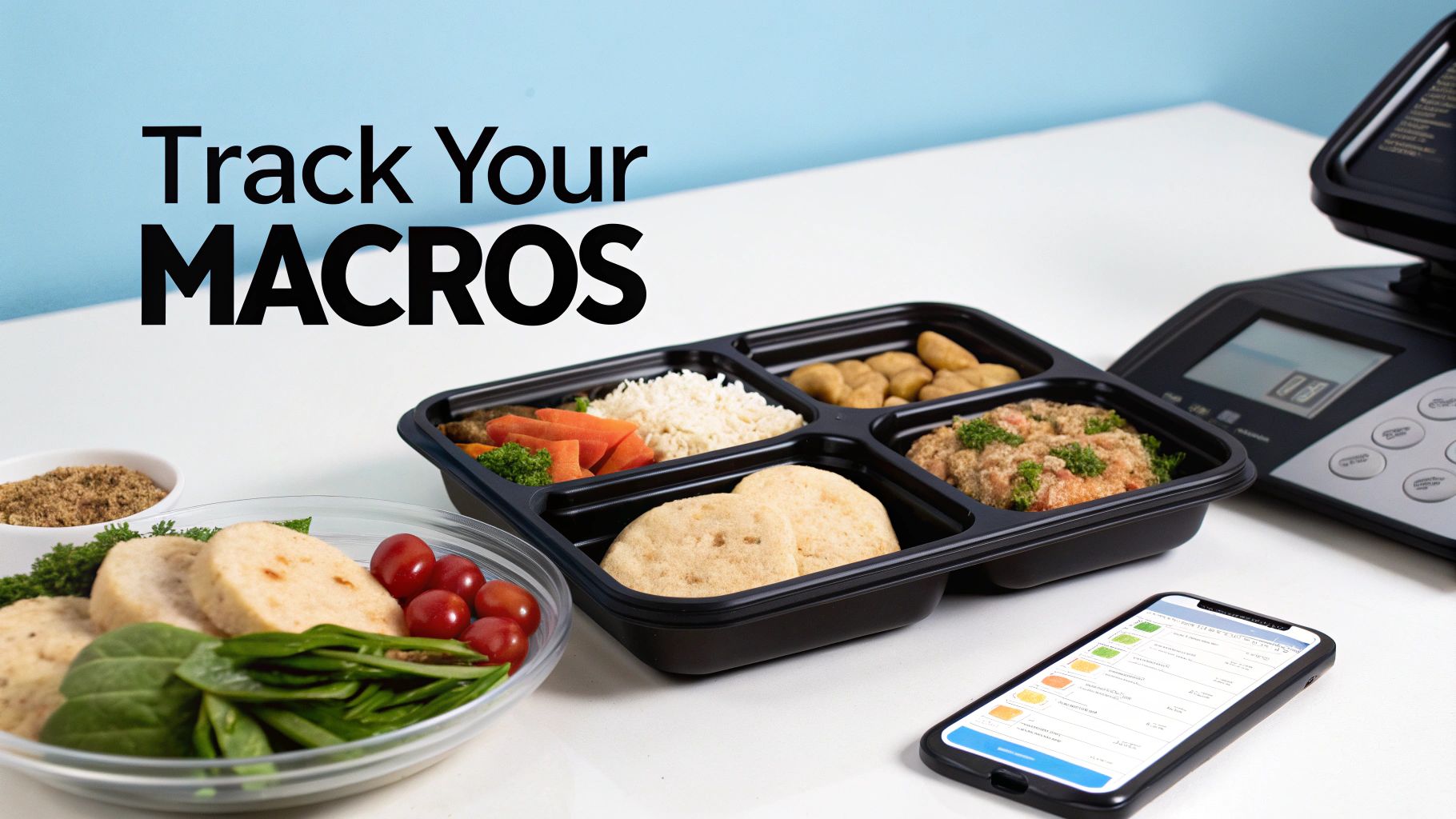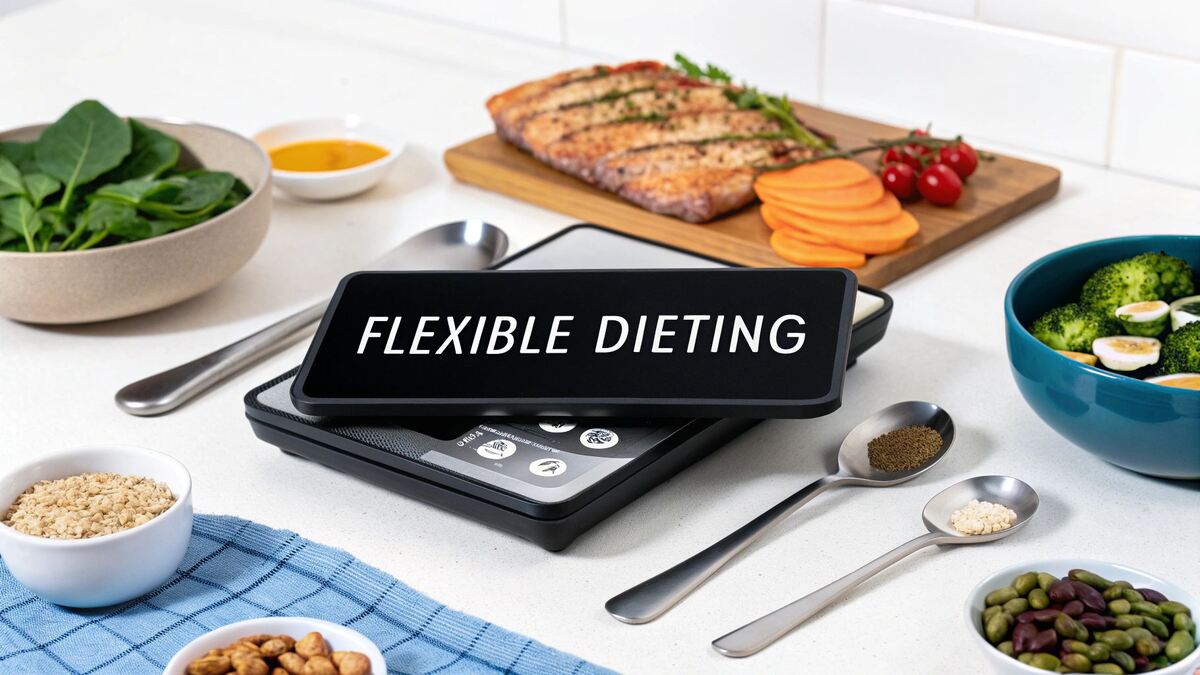What Is Flexible Dieting A Guide To IIFYM
Flexible dieting isn't about following a strict list of "good" and "bad" foods. Instead, it's a nutritional strategy that centers on hitting specific daily targets for macronutrients—protein, carbohydrates, and fats—giving you the freedom to choose what you eat, as long as it fits. The core idea is that how much you consume is just as critical as what you consume.
This approach lets you weave your favorite foods into your plan in moderation, making it far more sustainable than diets that force you to give up everything you love.
The Philosophy Behind Flexible Dieting
Think of your daily nutrition like a financial budget. But instead of money, your currency is grams of protein, carbs, and fats. Flexible dieting, often called 'If It Fits Your Macros' (IIFYM), hands you a personalized "macro budget" for the day. As long as you don't overspend, you get to decide which foods you want to "spend" it on.
This completely reframes the way you look at food. A slice of pizza is no longer a "cheat" or a sign of failure; it’s just an item with a certain macro cost. This shift helps break the cycle of guilt and shame that so often comes with restrictive eating, turning nutrition into a game of numbers and awareness, not a list of rigid, unbreakable rules.
Where Did Flexible Dieting Come From?
The idea really took off in bodybuilding circles around the early 2010s. Bodybuilders realized they could achieve incredible results by tracking their macros instead of just counting calories or cutting out entire food groups. This method allowed for a huge variety of foods, provided they fit within the daily targets calculated from an individual's height, weight, activity level, and goals. You can dive deeper into the origins and principles of flexible dieting from health experts at WebMD.com.
Flexible Dieting vs Traditional Dieting
The biggest difference comes down to mindset. Traditional diets hand you a list of "allowed" and "forbidden" foods, which can feel incredibly restrictive. Flexible dieting gives you a numerical framework and trusts you to make your own choices within it.

The table below breaks down the key philosophical differences between these two approaches.
Flexible Dieting vs Traditional Dieting at a Glance
This table provides a quick, scannable comparison between the core principles of flexible dieting and more traditional, restrictive dieting methods, highlighting key differences in approach and philosophy.
| Aspect | Flexible Dieting (IIFYM) | Traditional Restrictive Diets |
|---|---|---|
| Primary Focus | Meeting daily macronutrient and calorie targets. | Eliminating "bad" foods or entire food groups (e.g., carbs, fat). |
| Food Choices | All foods are permissible if they fit within your macro budget. | A strict list of "allowed" and "forbidden" foods. |
| Mindset | Empowers food freedom and personal responsibility. | Fosters an all-or-nothing mindset with "good" vs. "bad" labels. |
| Sustainability | High, as it adapts to social situations and personal cravings. | Low, often leading to burnout, guilt, and yo-yo dieting. |
| Psychological Impact | Reduces food-related anxiety and guilt. | Can increase the risk of disordered eating patterns and stress. |
This quick comparison makes it clear why flexible dieting often leads to better long-term success and a healthier relationship with food.
Flexible dietary control is associated with lower body mass and better psychological well-being than rigid control. This approach encourages sustainability by removing the psychological barrier of “cheating,” which is a significant predictor of long-term success.
Now, this doesn't mean you have a free pass to eat nothing but junk food. Most people who succeed with this approach naturally fall into an 80/20 rule:
- 80% of calories come from whole, nutrient-dense foods like lean meats, vegetables, fruits, and whole grains. These are the foods that keep you full and fueled.
- 20% of calories can be reserved for those more indulgent treats you truly enjoy.
This balance ensures you’re getting all the essential vitamins, minerals, and fiber your body needs while still enjoying the mental freedom that makes this a lifestyle, not a short-term diet. So, what is flexible dieting? It's a smart, adaptable system that teaches you about portion control and nutritional science, setting you up for a healthier relationship with food for life.
Understanding The Role Of Each Macronutrient
To get the hang of flexible dieting, you first need to understand what you're "spending" your macro budget on. These aren't just random numbers on an app; they're the fuel that runs your body, powering everything from building muscle to simply thinking straight. Getting this balance right is what truly unlocks the power of flexible dieting.
So, let's take a closer look at the big three—protein, carbohydrates, and fats—and what they actually do for you. Each one has a unique and vital job to do.
Protein: The Body Builder
Think of protein as your body's construction crew. It's made up of amino acids, which are like the individual LEGO bricks used to build and repair tissues. This includes your skin and hair, but for most of us hitting the gym, it's all about muscle. When you work out, you create tiny micro-tears in your muscle fibers; protein is what your body uses to patch them up, making them bigger and stronger.
But that’s not all it does. Protein is also incredibly satiating, which is a fancy way of saying it helps you feel full and satisfied for longer. This is a game-changer when you're trying to lose weight, as it helps keep hunger and cravings under control. A diet high in protein is key to holding onto your hard-earned muscle while dropping fat.
A 2021 study on people who lift weights found that a high protein intake—around 2 grams per kilogram of body weight—was crucial for maintaining muscle during a 10-week fat loss phase. What’s really interesting is that both flexible and rigid dieters lost fat at a similar rate, proving just how important protein is, no matter how you structure your diet.
If you're struggling to get enough, checking out a high-protein meal plan can give you some great ideas and recipes to help you hit your daily goals.
Carbohydrates: The Energy Source
Carbs have been villainized for years, but the truth is, they're your body's number one choice for fuel. Think of carbohydrates as the premium gasoline for your engine—they power you through tough workouts and keep your brain sharp. When you eat carbs, your body breaks them down into glucose for immediate energy or stores it as glycogen in your muscles for later.
This is exactly why you might feel sluggish and foggy on a super low-carb diet. You're essentially running your body and brain on low-grade fuel. Focusing on complex carbs like oats, brown rice, and veggies gives you a slow, steady stream of energy, helping you avoid that dreaded afternoon crash.
Fats: The Hormone Regulator
Fat is not the bad guy. In fact, it's absolutely essential for your health. Healthy fats are like the master regulators working behind the scenes. They play a critical role in producing hormones (like testosterone), absorbing key vitamins (A, D, E, and K), and keeping your brain healthy. Without enough fat in your diet, a lot of your body's most important systems would start to sputter.
The trick is to focus on the right kinds. You want to prioritize unsaturated fats from good sources:
- Monounsaturated Fats: Found in things like olive oil, avocados, and almonds.
- Polyunsaturated Fats: Found in walnuts, flaxseeds, and fatty fish like salmon (which is packed with omega-3s).
Learning to balance these three macronutrients is what flexible dieting is all about. It’s not just about hitting numbers; it's about understanding why those numbers matter. By giving your body the right mix of building blocks, energy, and regulators, you turn your diet from a list of rules into a powerful tool to crush your goals.
How to Calculate Your Personal Macro Targets
Alright, so you know what protein, carbs, and fats do. Now for the fun part: figuring out your specific numbers. Calculating your macro targets is the engine that makes flexible dieting run. Don't worry, it's less about complicated math and more about creating a personalized roadmap for your body and goals.
The whole process boils down to three main steps. First, we'll figure out how much energy your body needs just to maintain its current weight. Then, we'll tweak that number based on whether you want to lose fat or build muscle. Finally, we'll split those calories up into your daily protein, carb, and fat goals. Let's walk through it.
Step 1: Find Your Maintenance Calories
Your journey starts with finding your Total Daily Energy Expenditure (TDEE). It sounds technical, but it’s just the total number of calories your body burns in a 24-hour period—from sleeping and breathing to hitting the gym. Think of it as your body's "break-even" point. Eating this many calories will keep your weight stable.
While online calculators can give you a quick answer, you can get a solid estimate on your own.
Calculate Your Basal Metabolic Rate (BMR): This is the energy your body needs just to exist, even if you were lying in bed all day. The Mifflin-St Jeor equation is a popular formula, but a quick and dirty estimate is to multiply your body weight (in pounds) by 10. For a 180-pound person, that's about 1,800 calories.
Add an Activity Multiplier: Now, we account for your lifestyle. Take your BMR and multiply it by the factor that best describes your daily activity.
- Sedentary (desk job): BMR x 1.2
- Lightly Active (light exercise 1-3 days/week): BMR x 1.375
- Moderately Active (moderate exercise 3-5 days/week): BMR x 1.55
- Very Active (hard exercise 6-7 days/week): BMR x 1.725
Let's stick with our 180-pound person who is moderately active. Their calculation looks like this: 1,800 (BMR) x 1.55 = 2,790 calories. That's their estimated TDEE, or maintenance level.
Step 2: Adjust For Your Goal
Once you have your TDEE, you need to adjust it based on what you're trying to accomplish. This is where you create a calorie deficit to lose fat or a calorie surplus to build muscle.
The key to long-term success is a sustainable rate of change. Making drastic cuts might seem tempting, but it can backfire by causing muscle loss and slowing down your metabolism. A moderate adjustment of 15-20% is a proven and much smarter starting point.
Here’s how that looks in practice:
- For Fat Loss: Subtract 15-20% from your TDEE. For our example, a 20% deficit from 2,790 calories is 558 calories. That brings the new daily goal to 2,232 calories.
- For Muscle Gain: Add 10-15% to your TDEE. A 10% surplus would be 279 calories, setting the daily goal at 3,069 calories.
- For Maintenance: No math needed here! Just stick with your calculated TDEE.
This adjusted number becomes your new daily calorie "budget."
Step 3: Set Your Macronutrient Targets
The final piece of the puzzle is dividing that calorie budget into grams of protein, carbs, and fats. This is what puts the "macros" in "tracking your macros." Just remember the calorie value for each:
- Protein: 4 calories per gram
- Carbohydrates: 4 calories per gram
- Fats: 9 calories per gram
This infographic gives a great visual breakdown of what each macro is doing for you.

As you can see, protein is for building, carbs are for energy, and fats are crucial for hormonal and brain health.
Let's break down the calories for our fat loss example (2,232 calories):
Set Your Protein: This is your non-negotiable macro, especially when in a deficit. A solid rule of thumb is 1 gram per pound of your target body weight. If the goal is 165 lbs, that’s 165g of protein. (165g x 4 cal/g = 660 calories).
Set Your Fats: Healthy fats are essential. Aim for 20-30% of your total daily calories to come from fats. Let's split the difference and use 25%: (0.25 x 2,232 calories = 558 calories). To get the grams, divide by 9: (558 / 9 = 62g of fat).
Calculate Your Carbs: Whatever calories are left over are for carbs. Simply subtract your protein and fat calories from your total: 2,232 - 660 (protein) - 558 (fat) = 1,014 calories. To find the grams, divide by 4: (1,014 / 4 = 254g of carbs).
So, the final daily macro target for our fat loss example is:
- Protein: 165g
- Fats: 62g
- Carbohydrates: 254g
Think of these numbers as your starting line, not a finish line set in stone. Your body is dynamic and will adapt, so be ready to make small tweaks every few weeks based on your progress. If you'd rather skip the math and get a solid framework built on these same principles, a professionally designed balanced meal plan can be a fantastic place to start.
The Essential Tools for Tracking Macros
Alright, so you've got your personal macro targets. That's a huge first step. But the real key to making flexible dieting work is consistency, and hitting those numbers day after day requires a couple of simple but powerful tools.
The good news? You don’t need any expensive gadgets or complicated software. These essentials just take the guesswork out of the equation, turning what might feel like a chore into a simple daily habit. Let's look at the absolute non-negotiables.
The Digital Food Scale: Your Foundation for Accuracy
If you only get one thing, make it a digital food scale. Seriously. While measuring cups and spoons seem close enough, they just aren't accurate enough for tracking macros. The difference between a level cup of oats and one that's slightly heaping can easily be 50 calories or more. Those little errors add up fast and can be the very thing that stalls your progress.
A food scale gets rid of all that ambiguity. When you weigh your food in grams, you get the exact data you need for your log. This isn't about being obsessive; it's about being accurate so you can trust your numbers and make smart adjustments when you need to.
Tracking Apps: Your Digital Food Diary
Once you have accurate measurements, you need a simple way to log them. This is where a good tracking app becomes your best friend. Apps like MyFitnessPal, Cronometer, or Macrostax are built to make this process as painless as possible.
These apps have a few game-changing features that save a ton of time:
- Barcode Scanner: Just scan the barcode on a food package, and the app instantly pulls up all its nutritional info. Easy.
- Huge Food Databases: Most apps have millions of food items logged, including meals from popular restaurants, so you can track what you eat even when you're out.
- Custom Recipe Builder: You can plug in your own recipes, and the app does the math to figure out the macros per serving—a lifesaver for meal prep.
Here’s a quick look at the MyFitnessPal dashboard. You can see your macro goals and how your intake for the day is stacking up in real-time.

Those little progress bars give you instant visual feedback, showing you exactly how much protein, carbs, and fat you have left in your budget for the day.
AI Meal Planners: The Automation Solution
A scale and an app are the core essentials for tracking, but for some people, the daily grind of planning and logging is the biggest hurdle. This is where a little bit of automation can make all the difference.
The best diet is the one you can actually stick to. Any tool that reduces the mental effort and daily decisions is a massive asset for building habits that last.
This is where something like the AI Meal Planner comes in. It takes the principles of flexible dieting and automates the whole planning side of things. Instead of spending time figuring out what combination of foods will hit your numbers, the platform generates a full week of meals that perfectly match your macro targets. It’s the precision of macro tracking mixed with the convenience of a done-for-you plan—truly the best of both worlds.
Common Flexible Dieting Myths Debunked
Flexible dieting is a game-changer, but its name can definitely raise a few eyebrows. When you tell people you’re not following a strict list of "good" and "bad" foods, you’ll often get some skeptical looks, especially from those used to old-school, rigid diets. Let's clear the air and tackle the biggest myths out there.
Once we pull back the curtain on these falsehoods, you'll see what flexible dieting is really about: building a smart, balanced, and sustainable relationship with food.
Myth 1: It’s Just an Excuse to Eat Junk Food
This is easily the biggest misconception of them all. People hear "If It Fits Your Macros" and immediately picture a daily menu of protein bars, pizza, and ice cream. But that's a complete misunderstanding of how this works in the real world.
Sure, could you technically hit your macro targets with nothing but junk? Maybe for a day. But try doing it consistently. You’d feel awful.
Imagine trying to hit a high protein goal for the day while only eating fast food. You’d blow past your fat and carb limits long before you ever got close to your protein target. The system has built-in guardrails that naturally guide you toward better choices.
Anyone who sticks with flexible dieting learns quickly that to feel full, energized, and actually see results, the bulk of their diet has to come from quality sources.
That’s where the 80/20 rule comes in. It’s the approach most people naturally settle into:
- 80% of your calories come from whole, nutrient-packed foods—think lean meats, veggies, fruits, and whole grains.
- The other 20% is your fun money. It’s where you can fit in a cookie, a slice of pizza, or a scoop of ice cream without a shred of guilt.
This keeps you sane and satisfied while ensuring you get all the fiber, vitamins, and minerals your body needs to thrive.
Myth 2: It Promotes an Unhealthy Fixation on Numbers
Okay, I get it. At first, the idea of weighing and tracking everything you eat can sound a bit obsessive. But here’s the key: it’s not meant to be a life sentence. It’s an educational tool.
Think of it like learning to manage your finances. When you first create a budget, you track every single dollar to get a clear picture of where your money is going. After a while, you don't need to log every coffee; you just intuitively know what you can and can't afford.
Macro tracking is the exact same thing for your nutritional budget. It teaches you what a real portion size looks like and what’s actually in the foods you eat every day. After a few months of practice, you develop what’s called nutritional literacy. You can just eyeball a piece of chicken or a serving of rice and be pretty darn close.
That initial tracking period is a short-term investment that pays off for a lifetime, giving you the power to make smart choices without being glued to an app forever.
Myth 3: It Ignores Food Quality and Micronutrients
This one circles right back to the junk food myth. While the foundation of flexible dieting is hitting your macronutrient targets, it absolutely does not mean you should ignore micronutrients (all those essential vitamins and minerals).
At the end of the day, you're still in the driver's seat. Flexible dieting provides the road map, but you choose the vehicle. As nutrition experts often point out, this approach empowers people to choose foods they enjoy within their macro goals, which is why it works so well long-term. It gets rid of the 'bad food' label and instead asks how a particular food fits into your day. You can read more about how this balanced approach supports sustainable weight management on Healthline.com.
This system is built on personal responsibility. It’s a framework, not a free pass to forget everything we know about good nutrition. In fact, you can apply this framework to almost any eating style, even creating a flexible keto meal plan where food quality is a top priority.
The Lifestyle Benefits Beyond The Scale
Let's be honest, while the number on the scale might get you started, the real magic of flexible dieting is how it changes your life off the scale. It's about gaining freedom, not just losing pounds. This whole approach is designed to rebuild your relationship with food from the ground up, switching out fear and restriction for knowledge and balance.
Think about it: the endless cycle of labeling foods as "good" or "bad" is exhausting. When a cookie stops being a moral failure and becomes just a simple mix of carbs and fats that fits your daily numbers, the guilt just… vanishes. That mental shift is huge. It’s what finally breaks the all-or-nothing thinking that so often leads to a weekend binge and the classic "I'll start again on Monday" trap.
Developing True Food Freedom
At its core, flexible dieting is an education. That initial phase of tracking your macros? It’s not meant to be a lifelong obsession. Think of it as a short-term course in nutritional literacy 101. You quickly learn what a real serving of peanut butter actually looks like (it's smaller than you think!), how much protein is in a chicken breast, and how to put together a meal that keeps you full and energized for hours.
This is where the real power lies. Armed with this knowledge, you can walk into almost any restaurant, scan the menu, and mentally ballpark a dish to see how it fits your day. You're no longer just blindly following a rigid meal plan; you’re making informed decisions about how to fuel your own body.
"Rigid dietary control is associated with higher BMI and greater psychological distress, while flexible control is associated with healthier weight management.” This isn't just a hunch; the mental freedom flexible dieting provides is directly linked to better, more sustainable physical results.
That confidence completely changes how you handle social events. Birthday parties, holiday dinners, nights out with friends—they're no longer minefields of anxiety. You don't have to choose between your diet and your social life. Instead, you learn how to make them work together.
A Diet That Adapts To Your Life
Rigid diets demand your life bend to their will. Flexible dieting does the opposite—it's designed to bend with yours. Life is messy and unpredictable. Some days are a chaotic mess of meetings and errands that call for a quick, on-the-go meal. Others are slow, leaving plenty of time to cook something from scratch. This method handles both scenarios beautifully.
This is also why it's such a powerful tool for specific body composition goals. For example, many effective cutting strategies are built on these very principles of macro management. The framework is solid enough to support serious goals, from fat loss to muscle gain, but it never asks for perfection.
Ultimately, the real wins from mastering flexible dieting show up in your day-to-day life.
- Less Food Anxiety: You can finally eat a meal with family and friends without mentally calculating every bite.
- More Confidence: You feel in control of your nutrition, rather than feeling controlled by it.
- Real Sustainability: It stops being a "diet" and simply becomes the way you eat—an intuitive, lifelong habit.
In the end, flexible dieting isn't just about hitting a goal weight. It's a system for achieving your goals while still living a full, vibrant, and enjoyable life. You learn balance, build resilience, and create a genuinely healthy relationship with food that can last a lifetime.
Your Flexible Dieting Questions Answered
When you first start digging into flexible dieting, it’s only natural for questions to pop up. It’s a pretty straightforward approach, but as with anything, the details really matter. I’ve put together some clear answers to the most common questions I hear, hoping to give you the confidence to get started.
Think of this as your personal FAQ for all those "what if" moments that inevitably arise.
Do I Have to Hit My Macros Perfectly Every Day?
Let me be clear: absolutely not. Chasing perfection every single day is the fastest way to burn out and give up. The real goal here is consistency, not daily perfection.
A much better way to think about it is getting close to your targets. A good rule of thumb is to land within 5-10 grams of your protein and carb goals, and within 2-5 grams of your fat goal. What truly makes a difference in the long run is your weekly average. Life happens, and this little bit of wiggle room is what makes flexible dieting sustainable—it allows the diet to fit your life, not the other way around.
What About Micronutrients and Fiber?
This is a fantastic question, and it gets to the heart of doing flexible dieting right. While we talk a lot about macros, micronutrients (your vitamins and minerals) and fiber are completely non-negotiable for your health, energy, and digestion. Skipping over them is a rookie mistake.
The people who have the most success with flexible dieting live by an 80/20 rule. This means 80% of their food comes from whole, nutrient-rich sources—things like lean proteins, fruits, veggies, and whole grains. The other 20% is where the fun comes in—the treats and indulgences you love.
This simple balance ensures you're giving your body what it needs to thrive while still enjoying the freedom that makes this whole thing work long-term. And don't forget your fiber! Aiming for around 25 grams for women and 38 grams for men each day is a solid target for keeping your digestive system happy.
How Do I Track Alcohol?
Ah, alcohol—the tricky fourth wheel. It has calories (7 calories per gram), but it's not a protein, carb, or fat, which can make tracking confusing. So, how do you fit it in without throwing off your numbers? The easiest way is to "borrow" the calories from your carb or fat allowance for the day.
Here’s a simple, two-step way to do it:
- Get the Total Calories: Look up the total calorie count for your drink.
- Convert to Carbs or Fats: See where you have more room in your daily budget.
- To count it as carbohydrates, just divide the total calories by 4.
- To count it as fats, divide the total calories by 9.
Let's say you're having a 150-calorie glass of wine. You could log that as 37.5g of carbs (150 / 4) or about 16.7g of fat (150 / 9). This little trick lets you enjoy a drink with friends and still stay on track with your overall goals.
Ready to stop guessing and start seeing results? The AI Meal Planner takes all the complexity out of hitting your macro targets by generating a delicious, personalized meal plan just for you. Get started and build your perfect plan today.
AI-powered nutrition
Get Your Personalized Meal Plan
AI creates the perfect meals for your goals, lifestyle, and taste.
Start Your Journej
